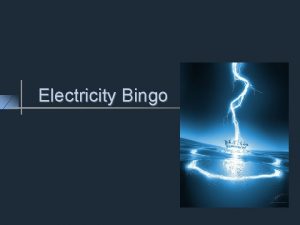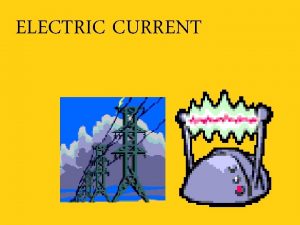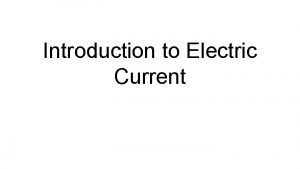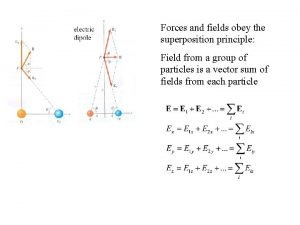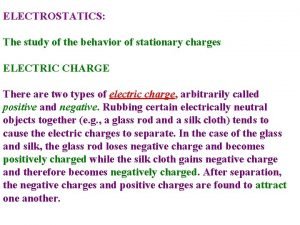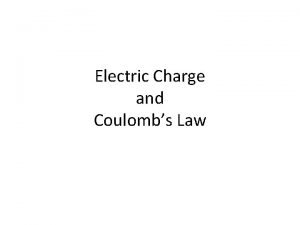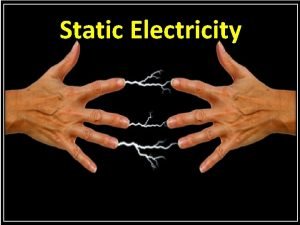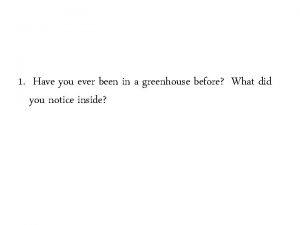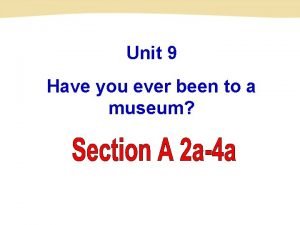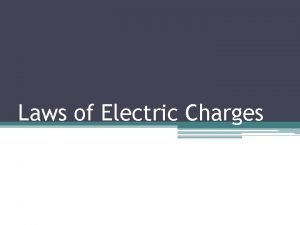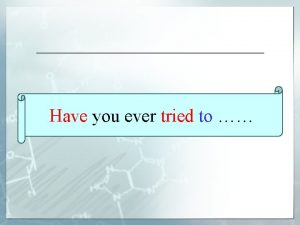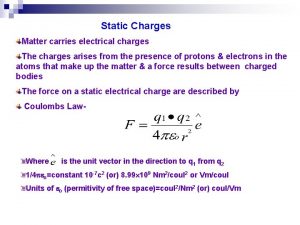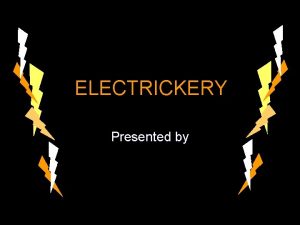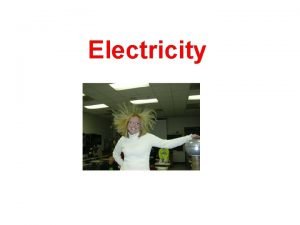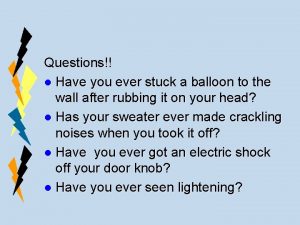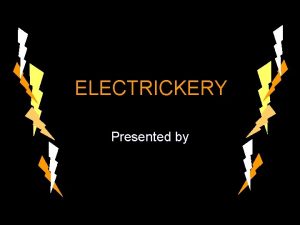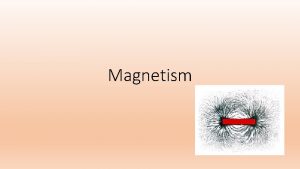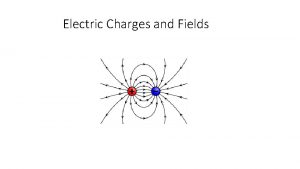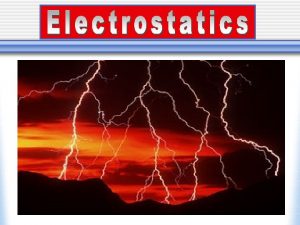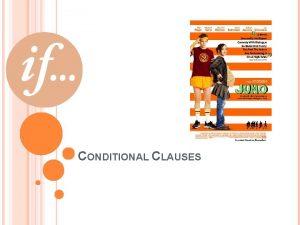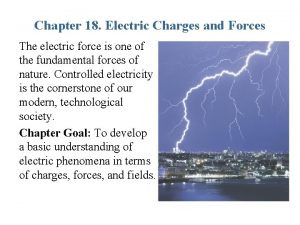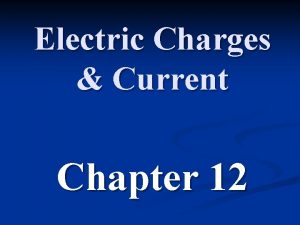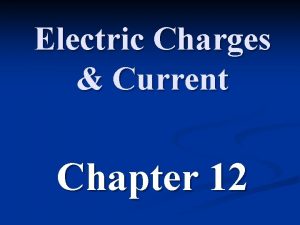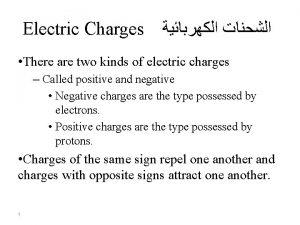Section 1 Electric Charges Have you ever stuck




























- Slides: 28

Section 1 – Electric Charges

Have you ever stuck a balloon to the wall after rubbing it on your head? l Has your jumper ever made crackling noises when you took it off? l Have you ever got an electric shock off your door knob? l Have you ever seen lightening? l

All these things happen because of Static Electricity

What is Static Electricity? Static electricity occurs when there is a build up of electric charge on the surface of a material. l It is called static electricity because the charges don’t move. l The electricity we use everyday involves moving charges. l

What is charge? To understand charge we have to look at things on an extremely small scale. l We have to try and understand things that we can’t even see with the most powerful microscope. l Atoms!

The atom l l Everything we see around us everyday is made of atoms. We can’t see individual atoms because they are so small. In fact the diameter of an atom is about 0. 000001 m In the air in your classroom there about 150000000000000 atoms.

What is inside the atom? l The atom is made of 3 sorts of particles. The electron The proton The neutron l We can imagine each as a tiny little ball.

Inside an atom l The protons and neutrons sit together in a lump in the middle called the nucleus. l The electrons orbit around the nucleus, a bit like the planets orbiting the Sun. Most of the atom is empty space if atoms were the size of football fields, the nucleus would be a grain of sand in the middle and the electrons would be orbiting around the edge. .

Charge l l l The electron is negatively charged. The proton is positively charged. The neutron has no charge, it is neutral.

Charge Most things have the same number of electrons and protons in them. We say they are neutral l They don’t have any overall charge. l If this isn’t true interesting things can happen. l

How do charges behave? l What do you know about magnets? l 2 north poles will repel each other, but a north and a south put together will attract one another. opposites attract, likes repel.

How do charges behave? l l l Exactly the same thing happens with charges. 2 positive charges put together will repel each other. Put a positive charge near a negative charge and they will attract each other. A charged object may even attract a neutral one. These are called the Laws of Charges

Static electricity is caused when certain materials are rubbed against each other. l Electrons can be rubbed off one material and on to another. l The material that has got extra electrons is now negatively charged l The material which has lost electrons is positively charged. l








Static electricity It is this imbalance of positive and negative charges that causes: l Balloons to stick to walls. l Your hair to stand on end when brush your hair on a dry day. l And the electric shock you sometimes get from the door handle. l

Conductors, Insulators and In-between l l An insulator does not allow charges to flow. They hold static electricity. Plastics, wood, and glass are insulators. A conductor allows charges to flow freely, they don’t hold static electricity. Metals make good conductors. A semi-conductor allows more movement of charge than an insulator but not as much as a conductor. A superconductor offers almost no resistance to charges, they work best at cold temps and are used to carry high charges.

Neutralizing Charge l Static charges are discharged or neutralized when they can escape through a conductor. l Connecting to the Earth is called grounding and provides a way for electrons to discharge. Grounding straps often drag from cars. l Ionization also can neutralize a charged object by adding ions (+ or -) to the object until the charges are balanced. Antistatic Sprays can dissipate charges to avoid static cling. l

Lightning

What causes lightning? l l l Lightning is actually just static electricity on a much larger scale. The rubbing is caused by air moving around In thunderclouds bottom is usually negative and top is positive.

Thunder l When the lightning flash happens it heats the air to a temperature 5 times hotter than the surface of the sun. l This causes nearby air to expand vibrate forming the sound we hear as thunder.

Interesting facts Lightning bolts can travel at speeds of up to 60, 000 miles per second. l Every second around 100 bolts of lightning strike the Earth. l One lightning bolt has enough electricity to power 200, 000 homes. l You are more likely to be struck by lightning than be eaten by a shark. l

Some myths l l Lightning never strikes in the same place twice. False, the Empire State Building is reportedly struck 100 times a year. Wearing rubber shoes will protect me in a thunder storm. False, Lighting is too powerful to be stopped by half an inch of rubber or several hundred feet of rubber for that matter.
 Electric charges and electric forces lesson outline
Electric charges and electric forces lesson outline Like charges blank and opposite charges blank
Like charges blank and opposite charges blank Ever ancient ever new
Ever ancient ever new Ever ancient ever new
Ever ancient ever new Ever ancient ever new
Ever ancient ever new Ever tried ever failed no matter
Ever tried ever failed no matter Electric current is the movement of
Electric current is the movement of The figure shows three electric charges labeled
The figure shows three electric charges labeled What is the continuous flow of electric charge?
What is the continuous flow of electric charge? Superposition principle electric field
Superposition principle electric field Study of stationary electric charges is
Study of stationary electric charges is Electron volt
Electron volt Same sign repel
Same sign repel Electric charge is
Electric charge is What is coulomb's law
What is coulomb's law Static electricity
Static electricity Have you ever done anything dangerous
Have you ever done anything dangerous Have you ever wondered
Have you ever wondered Warehouse inventory shrinkage statistics
Warehouse inventory shrinkage statistics Have you ever read this book
Have you ever read this book Folkways
Folkways Have you ever climbed a mountain
Have you ever climbed a mountain Have you ever been down
Have you ever been down Have you ever ridden a camel?
Have you ever ridden a camel? Have you ever climbed a mountain
Have you ever climbed a mountain Have you ever been to britain
Have you ever been to britain Have you ever been to disneyland
Have you ever been to disneyland Have you ever watched people
Have you ever watched people What are stanzas in a poem
What are stanzas in a poem

